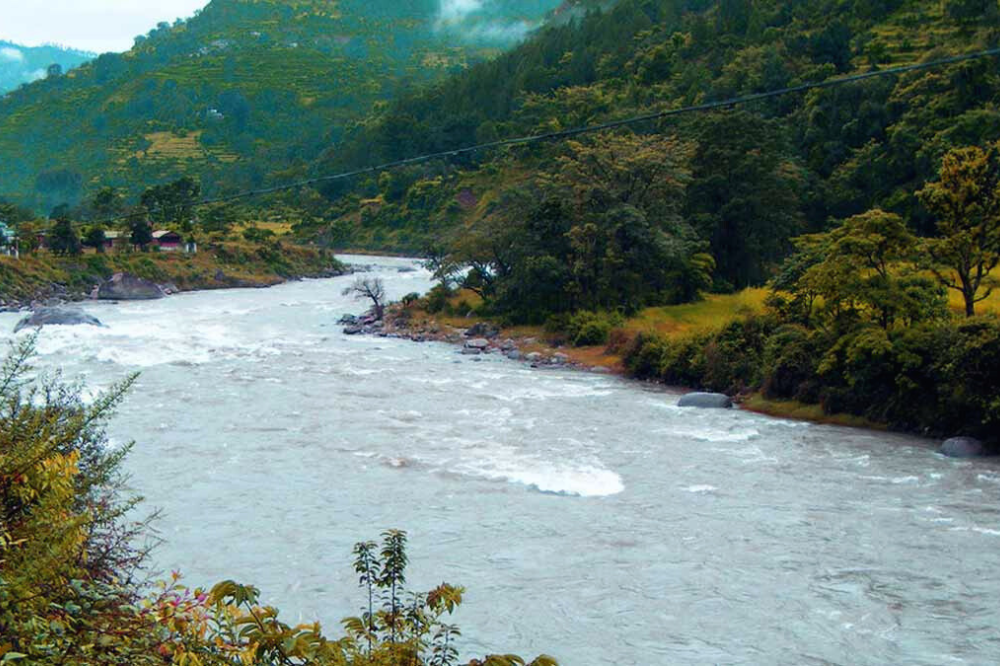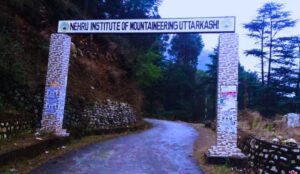The Mandakini River, flowing through the serene landscapes of northern India, is a lifeline that has sustained communities, cultures, and ecosystems for centuries. Originating from the heart of the Garhwal Himalayas, this river plays a significant role in shaping the geography, history, and daily lives of the people residing along its course. From its source to its confluence with the Alaknanda River, the Mandakini weaves a tale of resilience, spirituality, and ecological importance.
The Source and Journey
The Mandakini River finds its origin in the Chorabari Glacier, situated at an altitude of about 3,800 meters in the Rudraprayag district of Uttarakhand, India. Emerging from this pristine glacier, the river rushes down the steep slopes of the Garhwal Himalayas, carving its path through dense forests, meadows, and rocky terrains. Its course takes it through picturesque locations such as Kedarnath and Sonprayag, offering breathtaking views of the surrounding mountain ranges and inviting pilgrims and adventurers alike to explore its beauty.
Cultural Significance
The Mandakini River holds immense cultural significance in the region. It is intertwined with the lives of the local communities, especially those who follow Hinduism. Kedarnath, one of the holiest shrines in Hinduism, lies on the banks of the Mandakini. Thousands of devotees undertake the arduous trek to Kedarnath to seek blessings and solace in the lap of the mighty Himalayas. The river’s presence adds to the spiritual ambiance of the area, with its clear waters often used for ritualistic purposes.
Ecology and Biodiversity
The Mandakini River basin supports a rich variety of flora and fauna. The river’s waters provide sustenance to a diverse array of aquatic life, including various species of fish. The forests along its banks serve as habitats for numerous plant and animal species, some of which are endemic to the region. However, the delicate balance of this ecosystem is under threat due to factors such as deforestation, pollution, and climate change. Conservation efforts are crucial to preserve the river’s ecological integrity.
Challenges and Conservation
Like many other rivers around the world, the Mandakini River faces a range of challenges. Human activities, such as unchecked urbanization, industrialization, and improper waste disposal, have led to water pollution and degradation of the river’s water quality. The region’s vulnerability to landslides and flash floods further exacerbates these challenges. To address these issues, collaborative efforts between local communities, government bodies, and environmental organizations are essential. Strict regulations, sustainable development practices, and awareness campaigns can contribute to the conservation of this vital resource.
Quick Facts
Location: Northern India, originating from the Chorabari Glacier in Uttarakhand.
Length: Approximately 72 kilometers.
Significance: Cultural and spiritual importance due to its association with Kedarnath.
Ecological Importance: Supports diverse aquatic and terrestrial ecosystems.
Challenges: Pollution, deforestation, and vulnerability to natural disasters.
Conservation: Collaboration between communities, government, and organizations is crucial.
Call to Action: Preserve and protect the Mandakini River for future generations.
The River’s Role in Agriculture and Livelihoods
Beyond its cultural and spiritual significance, the Mandakini River plays a pivotal role in sustaining agriculture and livelihoods along its course. The fertile soils of its floodplains are cultivated for various crops, providing a source of sustenance for local communities. Farmers rely on the river’s waters for irrigation, enabling the cultivation of crops such as rice, wheat, and vegetables. The river’s contributions to agriculture underscore its importance as a lifeline that directly impacts the well-being and prosperity of the people residing in its vicinity.
Agricultural Practices and Challenges
In the towns and villages that flourish along the Mandakini’s banks, agricultural practices are deeply intertwined with the river’s ebb and flow. The monsoon rains that feed the river are eagerly awaited by farmers, as they mark the beginning of the planting season. Traditional methods of farming, passed down through generations, are adapted to the region’s unique climate and soil conditions. However, changing weather patterns and unpredictable rainfall due to climate change pose significant challenges to these agricultural practices. Adaptation to these challenges is essential to ensure food security and the continued prosperity of the communities.
Tourism and Recreation
The Mandakini River’s breathtaking landscapes, encompassing pristine forests, cascading waterfalls, and majestic mountains, attract nature enthusiasts, trekkers, and adventure seekers. The pilgrimage to Kedarnath draws devotees and tourists from all over the world, contributing to the local economy. The region offers opportunities for activities such as trekking, camping, and river rafting, allowing visitors to immerse themselves in the natural beauty and tranquility of the Himalayas. Responsible tourism practices are vital to ensure that the influx of visitors does not harm the fragile ecosystem and cultural heritage of the area.
Balancing Tourism and Conservation
While tourism brings economic benefits to the region, it also poses challenges to the delicate balance of the ecosystem. Waste generation, deforestation, and unregulated construction can have adverse effects on the river’s water quality and the surrounding environment. To strike a harmonious balance between tourism and conservation, it is crucial to implement sustainable tourism practices. This includes proper waste management, controlled construction, and raising awareness among tourists about the fragility of the ecosystem.
Lessons in Resilience
The Mandakini River and its surrounding communities have shown remarkable resilience in the face of natural disasters. The devastating flash floods of 2013, caused by the cloudburst and glacial melt in the region, highlighted the vulnerability of the area. However, the communities, along with government and non-governmental organizations, came together to rebuild and restore. The disaster emphasized the need for disaster preparedness, early warning systems, and sustainable land use planning to mitigate the impacts of such events in the future.
Building a Resilient Future
The lessons learned from the 2013 disaster have led to a renewed focus on building resilience in the region. Infrastructure development now incorporates disaster-resistant designs, and communities are trained in disaster response and evacuation procedures. Reforestation efforts are underway to stabilize the slopes and prevent landslides. These initiatives reflect a collective commitment to safeguarding lives, property, and the environment in the face of adversity.
A River of Unity and Diversity
The Mandakini River symbolizes the unity amidst diversity that characterizes India. Its journey through various terrains, climates, and communities reflects the nation’s rich tapestry. From the spiritual fervor of Kedarnath to the agricultural fields and bustling towns along its banks, the river binds together the cultural, ecological, and economic threads of the region.
Celebrating Diversity
The Mandakini River is not just a physical entity; it embodies the unity of people from different walks of life. It reminds us of the interconnectedness of all living beings and the need to respect and nurture the diversity that enriches our world. By appreciating the river’s role in sustaining cultures and ecosystems, we can embrace the value of unity in diversity and work together to ensure its well-being for generations to come.
Future Prospects and Sustaining the Mandakini River
Looking ahead, the Mandakini River faces a critical juncture where thoughtful planning and conservation efforts are essential to ensure its continued vitality. As the world grapples with the impacts of climate change and the growing need for sustainable resource management, the Mandakini River presents an opportunity for innovative solutions that can serve as a model for other regions facing similar challenges.
Climate Resilience and Adaptation
The effects of climate change, including glacier melt, altered precipitation patterns, and increased extreme weather events, are projected to impact the Mandakini River basin. To build resilience, comprehensive climate adaptation strategies must be developed. This could involve creating early warning systems for flash floods, implementing water management practices that take changing rainfall patterns into account, and promoting sustainable land use practices to reduce vulnerability to natural disasters.
Reforestation and Biodiversity Conservation
Preserving the rich biodiversity along the Mandakini’s banks is crucial for the river’s health and the well-being of the surrounding ecosystems. Reforestation efforts can help stabilize slopes, prevent soil erosion, and provide habitat for diverse flora and fauna. Local communities, governmental agencies, and non-profit organizations can collaborate to establish tree nurseries, organize community planting events, and raise awareness about the importance of maintaining a balanced ecosystem.
Sustainable Agriculture and Water Management
Agricultural practices along the Mandakini’s floodplains need to adapt to changing climate conditions and water availability. Implementing water-efficient irrigation techniques, promoting crop diversification, and adopting organic farming methods can enhance agricultural productivity while minimizing water usage. Collaborative efforts between farmers, researchers, and agricultural extension services can facilitate the adoption of these sustainable practices.
Education and Awareness
Raising awareness about the importance of the Mandakini River among local communities, tourists, and policymakers is fundamental to its conservation. Educational programs can teach about the river’s ecological significance, cultural heritage, and the benefits of sustainable practices. By fostering a sense of ownership and responsibility, these initiatives can empower individuals to actively participate in its preservation.
A Shared Responsibility
The Mandakini River is not just a local or regional concern; it is a shared heritage that transcends geographical boundaries. Its waters are intimately linked to the lives of those who depend on it for their sustenance, livelihoods, and spiritual well-being. As global citizens, it is our collective responsibility to ensure that this precious resource is safeguarded for future generations.
International Collaboration
International cooperation can play a vital role in preserving the Mandakini River and similar ecosystems worldwide. Collaborative efforts can involve sharing best practices in water management, disaster resilience, and sustainable tourism. Furthermore, supporting research and initiatives that contribute to the scientific understanding of the river’s hydrology, ecology, and socio-economic dynamics can inform effective policies and interventions.
Conclusion
The Mandakini River weaves a story that encompasses cultural heritage, ecological diversity, and human resilience. Its significance extends beyond the physical landscapes it traverses; it embodies the values of unity, adaptability, and stewardship. By embracing sustainable practices, raising awareness, and fostering international cooperation, we can ensure that the Mandakini River’s journey continues to enrich the lives of present and future generations. As the river flows through time, may it remind us of our shared responsibility to protect and cherish the natural treasures that bind us to each other and to the world around us.
Frequently Asked Questions (FAQs) about the Mandakini River
Q1: Where does the Mandakini River originate?
A1: The Mandakini River originates from the Chorabari Glacier in the Garhwal Himalayas, located in the Rudraprayag district of Uttarakhand, India.
Q2: How long is the Mandakini River? A2: The Mandakini River has a length of approximately 72 kilometers, flowing through diverse terrains and landscapes.
Q3: What is the significance of the Mandakini River in Hinduism? A3: The Mandakini River is of great spiritual importance to Hindus due to its association with the Kedarnath shrine. Kedarnath, one of the Char Dham pilgrimage sites, is located on the banks of the Mandakini and attracts thousands of devotees each year.
Q4: What kind of aquatic life does the Mandakini River support? A4: The Mandakini River basin is home to a variety of aquatic life, including several species of fish. These fish species are an integral part of the river’s ecosystem and contribute to the region’s biodiversity.
Q5: How does the Mandakini River support agriculture? A5: The fertile floodplains along the Mandakini River are used for agriculture. Farmers rely on the river’s waters for irrigation, allowing them to cultivate crops such as rice, wheat, and vegetables that are essential for local livelihoods.





